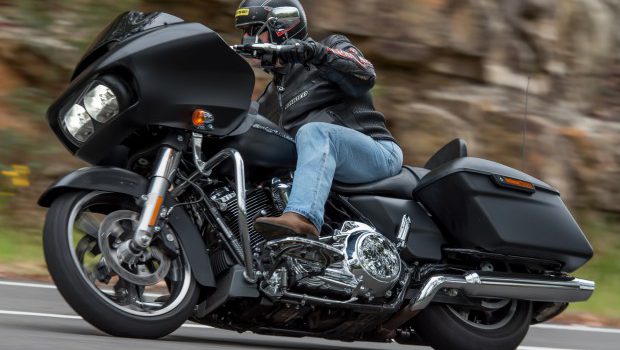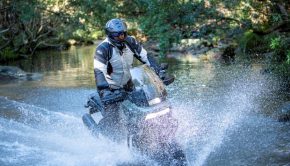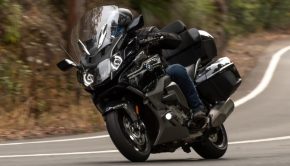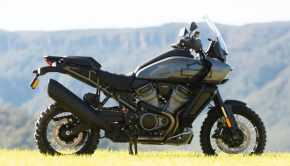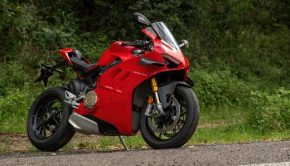2017 HARLEY-DAVIDSON ROAD GLIDE – THE MILWAUKEE EIGHT COMETH
Sometimes, the most profound revelations are pronounced over a cold beer.
I was sitting at a table with Neale Brumby (publisher of Heavy Duty) and Greg Leech (editor of Road Rider), and we were drinking and casting aspersions upon our enemies.
As always, our conversation turned to motorcycles when they ran out of enemies.
“You haven’t ridden the new Milwaukee 8 have you?” Brum asked.
I shook my head. “No. I’m a little bit late to the party. I pick one up on Monday.”
Brum and Leechy had just ridden up from Melbourne on two of the new Harleys and exchanged grins.
“What?” I said. “You two venerable old molls actually look like you know stuff I don’t.”
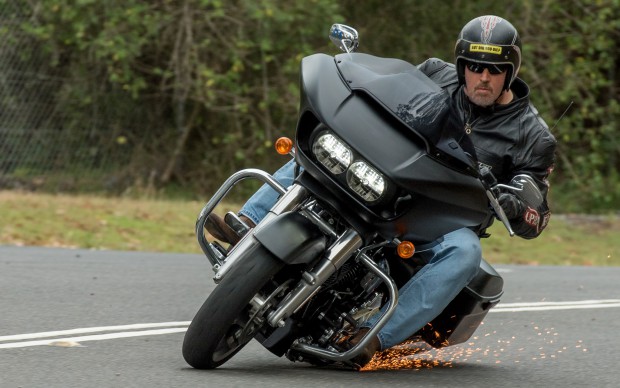
Be careful during bushfire season.
“We do,” Leechy said.
“We sure do,” Brum nodded.
I squinted at them both. “So this new Harley is that good, huh?”
Brum took a sip of his beer, placed it back on the table with gravitas and said: “I reckon this is as big a step forward for Harley as the Evolution engine was over the Shovelhead.”
I blinked at this pronouncement. There was a brief silence while I assimilated this information.
“That is a big call,” I eventually said.
Bum nodded. “It is. But that’s what I reckon.”
I looked at Leechy.
“It’s pretty good,” he said.
“You ride old Nortons,” I said to him. “Falling into a ditch would be pretty good to you.”
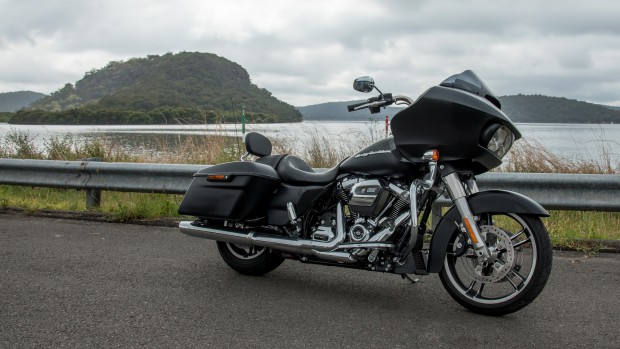
It surely does have some great road-presence.
The following Monday I presented myself at Harley-Davidson HQ, and was taken down into their fleet garage by Marcus.
“Which one do you want to ride?” he asked.
I love it when people ask me that.
“The Road Glide.”
Marcus nodded.
“You don’t want the orange Road King?”
I looked at him.
“The Road Glide is matte black. The Road King is orange. The choice, I would have thought, is obvious.”
I think it took me maybe four hundred metres and two gear-changes to realise that I was riding a very, very different Harley-Davidson.

The headlights are excellent at night, the fairing comes with vents you can open or close, and two little gloveboxes, one of which has a USB cable in it. Yes, of course it has Sat Nav and a radio.
Brumby was right. This new iteration is an enormous step forward by the factory. But it’s not just the engine, which is entirely new; the gearbox and suspension have also been transformed.
And so the entire bike is transformed
I will now take questions…
So this engine. It’s new, but eight-valve engines have been around for a while. What’s the big deal?
Pretty much everything. There are two engines – the 107-cubic-inch (1750cc) and the 114-cubic-inch (1870cc). The big one lives in the CVO models (Harley’s top-end bikes), and while the 107-cuber is now only in the Touring range of bikes, it will be in all of them eventually.
Now then, the Road King, Street Glide Special and Road Glide Special get oil-cooled heads. Then the Ultra Limited gets water-cooled heads, as do all the Custom Vehicle Operations (CVO) models, as well as the 114-cubic-inch donks.
Confused? Yeah, me too. If I was buying one, I’d choose the model I liked best and leave instructions with the sales-person that upon my return it would want to have the biggest-displacement engine in it and how that was going to happen would be his problem.

Mechanical things that go up and down. The light grey bits are called Rocker Arms, I believe. Because they look like arms and they rock.
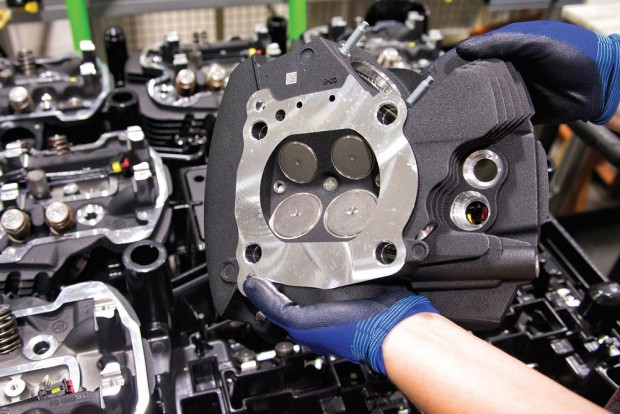
Valves. Two simple vowels away from being vulvas.
Technically, it kinda goes like this…
The new engine had to achieve two broad goals.
Number One was complying with draconian emissions while producing greater power and torque and being fuel efficient and highly reliable.
Number Two was a nebulous thing called “world-class ride feeling” via refinements to the suspension, chassis and gearbox.
Harley decided upon these goals after speaking to literally thousands of its customers.
The punters wanted an engine that idled at a lower rpm. They wanted an engine that ran cooler. They wanted an engine that punched harder when they twisted the throttle. They wanted an engine that vibrated less. They wanted better charging (accessories, dontcha know) and a richer exhaust note.
Harley delivered on all of this. After two weeks of riding the Street Glide every day, there was no doubt in my mind. This is in every way a better, and indeed quite the best, Harley ever made.
This “cooling” you speak of? Have they got fridges on them now?
It began with the recent Rushmore series of bikes and “strategic cooling”, ie. Liquid coolant was circulated in the passages around the cylinder head’s exhaust valve seat and then sent to an external radiator. The Eight has taken this concept even further.
The new eight-valve combustion chambers are flat, as opposed to the old deep (or ‘hemi’) four-valve chambers, thus the surface area through which heat can enter the chamber has been substantially reduced. Overall airflow has also been increased by more than 50 per cent, the throttle body is now at 55mm and the airbox has been redesigned to stay out of the way of your leg, breath in better and make less noise doing it.
Twin-plug heads are here also, speeding up combustion and thus also lowering heat, by flaming the heads and the pistons for a shorter time, and the engine timing has been advanced, or in the words of the engineer who designed it: “More advanced, more of the time.”
This means that up until the Milwaukee 8, Harley had been retarding the ignition in a bid to keep the heat down, which meant a loss of performance – and ironically more heat.
So now there is less heat and more performance. It’s like sorcery.
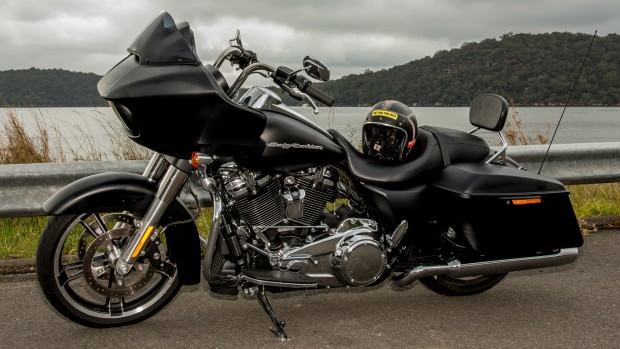
Waiting for mermaids to come out of the water.
There has been talk of some kinda bridge inside the heads. What’s that all about?
From what I can gather, the narrow region that separates each of the head’s two exhaust valves is critical to the performance of any four-valve head. This “exhaust bridge” tends to get very hot because it’s being sprayed with hot gases from both sides. The Milwaukee 8’s exhaust bridge is cooled by having oil pumped through it, which then runs into a small radiator that sits ahead of the crankcase. In the 107-cubic-inch and 114-cubic-inch Twin-Cooled models, coolant is circulated through a heart-shaped passage that runs around the exhaust valves and then through coolers on either side of the engine.
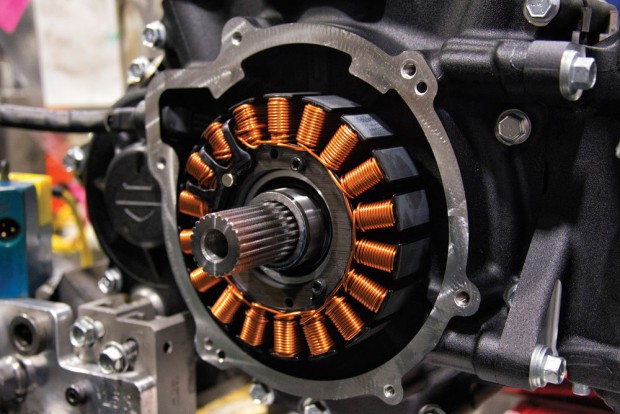
This is the stator. I once tried to rewind one by hand. I went mad and had to be shot.
I’m confused. What does this mean in terms of more bang?
Well, because the engine runs cooler, it can run higher compression ratios, like 10.5:1, and that means more power and torque. The factory claims 10 per cent more torque (and it certainly feels like that and more), and that means the bike is three-bike-lengths quicker to 100km/h, and two-bike-lengths quicker from 120km/h roll-ons than the previous model. Harley is also claiming better fuel economy because the engine is just more efficient at burning it.

The camshaft being shafted into its cam-hole-thing by an anonymous gloved had used to doing such things.
What’s an ion-sensing knock-detonation thing?
It’s rubbish. And it’s gone. Harley has replaced it with an acceleration-type knock system controlled by an ECU that prevents the engine from firing abnormally.
So it sounds like it’s cooler to ride?
Yes, big step here. The exhaust components and the baking catalytic converter have also been moved away from the rider and passenger.
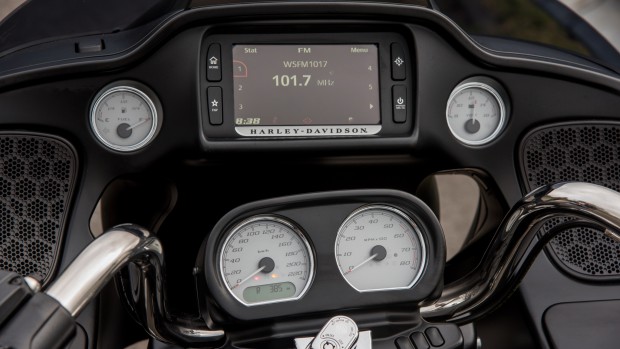
Don’t laugh at my choice of radio station. You’ll be old one day too. Speakers are good for about 110km/h.
And Harley has gone back to a single cam, yes?
Yes. Just like the original 1936EL, there is a single four-lobe camshaft, driven by a chain with an automatic hydraulic tensioner. This eliminates drive-train backlash and spreads the load over lots of sprocket teeth. Simple. And for the first time in a rubber-mounted Big Twin, a single counter-rotating internal balancer eliminates 75 per cent of the engine’s main shake. But you don’t want a Harley that doesn’t shake some. That’s all part of its appeal, and while Milwaukee could design an engine that doesn’t vibrate, its customer base simply doesn’t want it. What it settled on was this, and the result is excellent – a much smoother engine at all speeds, so it’s less tiring to ride, while still retaining that unique vibe. It now also idles at 850rpm instead of 1000.
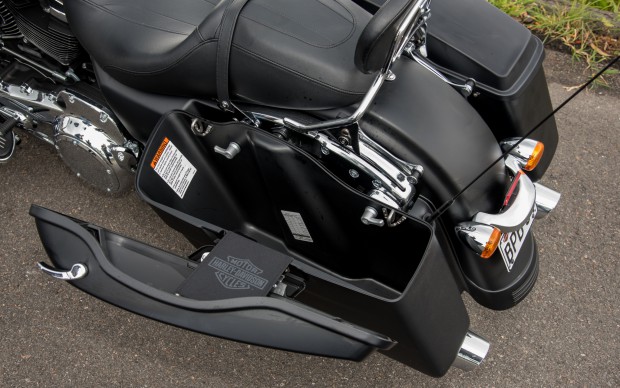
The bags now come with new simpler and sturdier releases. They will fit 17 cans and some ice.
So how does it go?
Astonishingly well. There is some real crack off stop and in the mid-range now, and it will sail quite happily over the 160km/h mark, whereas previous models were really working to get to the old ton and beyond. Not so the Milwaukee 8. It flies. The throttle response is excellent and the bike pulls much harder than I was expecting.
What else has been done?
Lots. The six-speed box is smooth. It’s actually 21st-century smooth now. The shifts are positive and even down-changing is not the crunch-fest it was last year.
The charging system now churns out 34amps instead of 17. The clutch is now a torque-assist unit with Brembo hydraulics, which requires less effort at the lever while offering better feedback. The 107 gets a nine-plate clutch and the 114 gets a ten-plate item. Happily, the derby cover is narrower than it was on the Twin Cam, so reaching the ground is easier for shorter legs. The engine ECU has been changed from a mapped command system to a torque-based system, which interprets the rider’s throttle position and delivers what’s being asked for. Harley also claims its forked rocker arms will require no adjustment for the life of the engine.

Harley make some very comfy seats. Still, a man can never do enough squats to help himself.
Suspension…please tell me they have upgraded the suspension.
Yep. Done. Both front and rear suspension is all new. There are now 49mm forks at the front with “dual bending valve fork technology”. This just means it has a cartridge with variable-orifice dampening, so the wallowing is gone as is the harshness over bumps. I found out how this actually works by Googling it. Those guys at Cycle World know everything:
“The words “bending valve” refer to how the variable orifices are implemented; in this case, the damping fluid’s flow path through the damper pistons is covered at rest by a thin washer that is clamped at its (usually) inner edge. As suspension motion pushes damping fluid faster, the free edge of the washer is deflected by fluid pressure, forced into a shallow cone shape as fluid is forced past it, allowing the flow path to become bigger. Correctly done, this results in damping force that is proportional to damper piston speed, giving a well-controlled and comfortable ride.”
Up the back, the rear unit has had larger pistons fitted and its pre-load range increased to 2.2cm, and you don’t need tools to do it. There’s a knob that you turn.

Yes, it’s a Showa. Or it could be a laser cannon.

Turn the knob, increase or decrease the pre-load up the back.
Can you stop now?
Yeah, OK. Sorry. But there are so many improvements, I really did have to address as many of them as I could understand.
At the end of the day, the Milwaukee 8 is a very big step into the future for Harley, so one gives credit where it is due. The bike feels an order of magnitude better to ride in every single way. Um, except brakes. There is still work to be done in that area, and while it does boast ABS, it’s a very noticeable ABS. Still, I have every confidence that Harley will address the brakes in its own good time. After all, the beast now belts along so well, better brakes are going to be very welcome.
Stylistically, you’d have to know what you’re looking at to see much difference between the Milwaukee 8 and previous models. The cognoscenti know, the casual observers just see a Harley.
But this new iteration will ensure they will be seeing Harleys for a good while yet.
In fact, I reckon the big American cruiser market is going to get more and more interesting in the years to come.
Harley has had this market to itself since the 50s. It serviced it as well as it felt it had to, and even when Victory appeared, the Milwaukee monolith wasn’t all that concerned.
But with the arrival of its old nemesis from Springfield, I reckon Milwaukee began paying attention.
The irony is amazing. In the beginning, George M Hendee’s Indian motorcycle was the benchmark Bill Harley and the Davidson brothers were chasing, then catching, then exceeding, then finally dancing on its bones in 1953.
The shoe is a little bit on the other foot now, with a resurgent and reborn Indian looking to make inroads into Harley’s formerly exclusive market.
The Milwaukee 8 is the first shot (and it’s a hell of a good one) that Harley has fired in what will be a truly glorious war for lovers of big American iron.
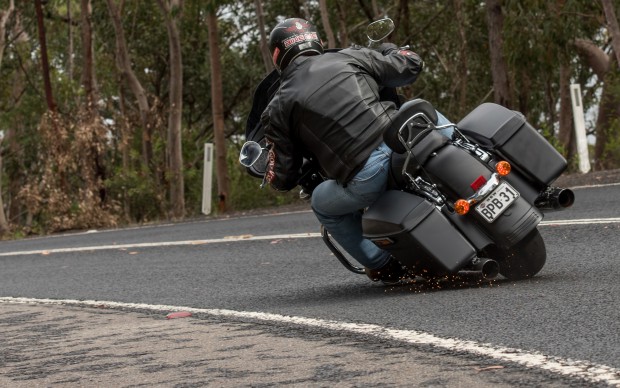
I’m always happy to be baggered.
You can view all the specs and models HERE
MY THANKS
Once again, the amazing Nick Edards of Halflight Photography made me look beaut. You should get him to shoot you by going HERE.

